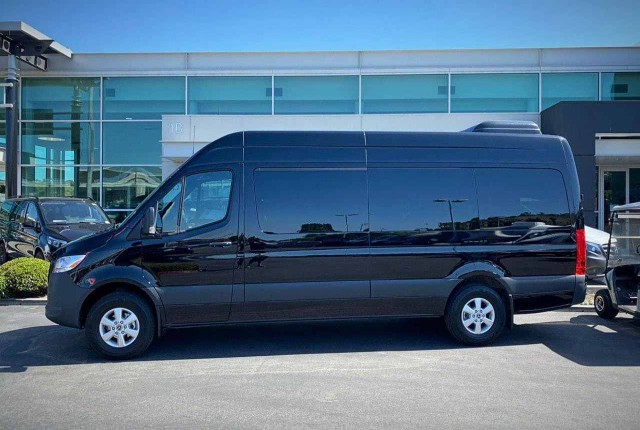 24 Nov-2023
24 Nov-2023
The Evolution of the Ford Transit Passenger Van showcases a remarkable journey from classic to modern design. The van's classic versions were built with a sturdy and functional design, and they were first presented for practical transportation purposes. Ford updated the Transit over time to become a contemporary wonder with svelte looks, cutting-edge technology, and enhanced safety features.
The Ford Transit Passenger Van has evolved to meet modern needs, continuing its heritage of dependability and utility while becoming a fashionable and adaptable option for passenger transportation.
The Birth of an Icon: Early Years (1965- 1985)
The years 1965–1985 saw the creation of an icon—the Ford Transit Passenger Van, which embodied adaptability and practicality. Its boxy shape, which was introduced in 1965, embodied utility and offered enough room for a variety of demands.
The van changed with cultural and economic dynamics, turning into a dependable workhorse for both individuals and companies. In response to the oil crisis of the 1970s, it prioritised fuel efficiency by upgrading its engines.
The 1980s saw a rise in technology as front-wheel drive was introduced, improving manoeuvrability. Beyond its initial business employment, the Ford Transit became well-liked for private use, which helped establish its lasting reputation as a reliable and adaptable vehicle.
Adapting to Change: 1986- 2000
The Ford Transit Passenger Van changed significantly between 1986 and 2000 as a result of the gradual evolution of the Ford Transit Passenger Van. The van changed during this time to accommodate new technology and changing consumer needs.
Updates to the design were made to improve fuel economy and aerodynamics, demonstrating a dedication to environmental concerns. The Ford Transit is now a popular option for a variety of applications, thanks to the integration of enhanced safety features and interior amenities.
During this time, modernization took the stage, guaranteeing that the van would always satisfy changing requirements and continue to be a dependable and flexible form of transportation.
Entering the Digital Age: 2001-2010
Between 2001 and 2010, the Ford Transit Passenger Van saw a radical metamorphosis as it entered the digital era. The van incorporated digital interfaces, enhanced safety measures, and electrical systems, fully embracing modern improvements.
Modern enhancements to the design included enhanced ergonomics, elegant lines, and a fuel-efficient emphasis that was in keeping with environmental concerns. The Ford Transit adopted cutting-edge diagnostics and connection technologies at this time to better fit the demands of the digital age.
Chicago van rental businesses have further enhanced convenience in today's digital world by providing the newest Ford Transit models with modern features for a smooth and comfortable travel experience.
Redefined Design and Efficiency: 2011- 2020
The Ford Transit Passenger Van had a redesign in 2011, which is a milestone in the evolution of the Ford Transit Passenger Van, and increased efficiency in 2020. Dynamic lines and a new visual makeover were applied to the outside, mirroring current automobile trends.
Modern interior design improves comfort and adaptability to meet a variety of passenger and cargo requirements. Innovations in technology took centre stage, with driver-assist systems and enhanced communication features becoming commonplace.
Fuel economy and environmentally conscious considerations propelled the progress, coinciding with a worldwide movement towards sustainability. During this time, the Ford Transit rose to prominence as a representation of efficiency by fusing innovative design with environmentally responsible engineering, making it a well-liked option for a range of transportation needs.
The Present and Beyond: 2021 Onwards
The evolution of the Ford Transit passenger van is at its peak in 2021 and beyond. The present models showcase refined aesthetics, incorporating sleek lines and a sophisticated exterior.
Interior advancements prioritise comfort, with state-of-the-art technology seamlessly integrated for an enhanced driving experience. Safety features have reached new heights, with advanced driver-assist systems becoming standard.
The Ford Transit remains at the forefront of connectivity, offering innovative solutions for both work and leisure. Looking ahead, the van is poised to continue its commitment to sustainability, exploring electric and hybrid options.
The Ford Transit Passenger Van stands as a testament to ongoing innovation, meeting the demands of contemporary transportation needs.
Conclusion: A Timeless Journey of Evolution
The evolution of the Ford Transit Passenger Van has set out on an enduring evolutionary path, continuously adjusting to the shifting demands of the transportation industry.
The van's development from its modest origins to the present has been characterised by a dedication to technology improvements, design improvement, and innovation. Some versions now have high roofs, which increases adaptability and provides more room for people and freight.
The Ford Transit continues to serve a variety of purposes while standing as a testament to its dependability and flexibility. In the future, the Ford Transit's heritage will continue with services like high roof 15-passenger van rentals, which provide a modern and roomy mode of transportation.
- 2025 May 31
Mercedes-Benz Sprinter 15-Passenger Van vs. Ford Transit 15-Passenger Van: Which Rental Is Better for Your Group?
- 2025 May 06
Epic Road Trip from Chicago: Yellowstone, Smoky Mountains & Grand Canyon in a Rental Van
- 2025 Mar 28
Why Chicago Van Rentals Are Ideal for Film Production Crew Transportation
- 2025 Mar 27
Art and Culture Tours: Using Van Rentals to Explore Chicago's Museums and Galleries
- 2025 Mar 20
Where to Travel from Chicago for Spring Break: Top Picks
